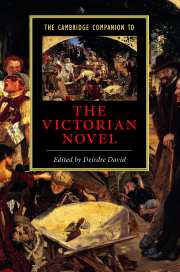Book contents
- Frontmatter
- Introduction
- 1 The Victorian novel and its readers
- 2 The business of Victorian publishing
- 3 The aesthetics of the Victorian novel: form, subjectivity, ideology
- 4 Industrial culture and the Victorian novel
- 5 Gender and the Victorian novel
- 6 Sexuality in the Victorian novel
- 7 Race and the Victorian novel
- 8 Detection in the Victorian novel
- 9 Sensation and the fantastic in the Victorian novel
- 10 Intellectual debate in the Victorian novel: religion, science, and the professional
- 11 Dickens, Melville, and a tale of two countries
- Guide to further reading
- Index
3 - The aesthetics of the Victorian novel: form, subjectivity, ideology
Published online by Cambridge University Press: 28 May 2006
- Frontmatter
- Introduction
- 1 The Victorian novel and its readers
- 2 The business of Victorian publishing
- 3 The aesthetics of the Victorian novel: form, subjectivity, ideology
- 4 Industrial culture and the Victorian novel
- 5 Gender and the Victorian novel
- 6 Sexuality in the Victorian novel
- 7 Race and the Victorian novel
- 8 Detection in the Victorian novel
- 9 Sensation and the fantastic in the Victorian novel
- 10 Intellectual debate in the Victorian novel: religion, science, and the professional
- 11 Dickens, Melville, and a tale of two countries
- Guide to further reading
- Index
Summary
Lord Jim (1900) by Joseph Conrad and Wuthering Heights (1847) by Emily Bronte, published fifty-three years apart, ostensibly have little to do with each other aesthetically or ideologically. One is written by a man; one by a woman. One by an emigre and one by a native Briton. One is overtly a text of diasporic imperialism and the other a text of domestic colonizing. One is constructed leisurely in the impressionist-realist mode, with a fast paced romantic, even gothic, finale; the other is a dramatically bifurcated text, a domestic hybrid of romance and realism. Conrad's is usually classified as modernist; Bronte's is classified as Victorian. While Lord Jim is considered aesthetically typical of its historical moment, Wuthering Heights is considered an aberration.
Yet these two novels, which may be said temporally to frame the Victorian novel despite its official beginning a decade before Wuthering Heights and despite the very real difference between them, can be connected through issues of form, subjectivity, and ideology. The topic for this chapter is, of course, large and even unwieldy. It reminds me, in its scope, of what the words “Victorian novel” usually summon up in our minds: huge casts of characters, complex plots, cliffhanger sections due to serialization, even three-decker novels. By using Lord Jim and Wuthering Heights as a window on aesthetic and ideological transformations in the era's fiction, I am concerned to trace permutations and innovations in the Victorian novel and to show how it both registers historic pressures and alters aesthetically under them.
- Type
- Chapter
- Information
- The Cambridge Companion to the Victorian Novel , pp. 61 - 76Publisher: Cambridge University PressPrint publication year: 2000
- 3
- Cited by



